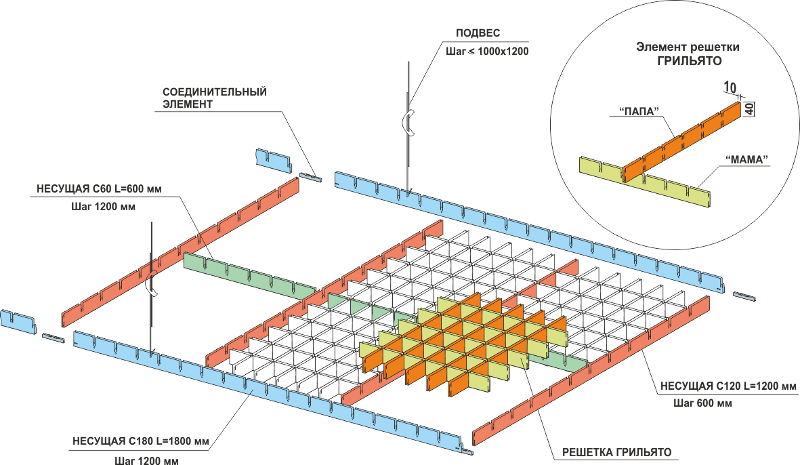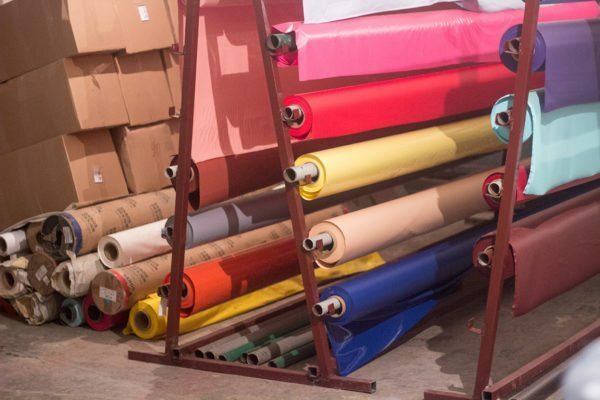SHARE
IN SOCIAL MEDIA
Stretch ceilings are distinguished by excellent moisture resistance, as well as the ability to stretch. In case of flooding, such a finish will allow you not to worry about the safety of repairs and furniture. In order not to catch an unpleasant surprise from the neighbors by surprise, it is better to know in advance how to drain the water from the stretch ceiling. The information presented in this article will help you quickly navigate in a crisis situation and properly coordinate your actions.
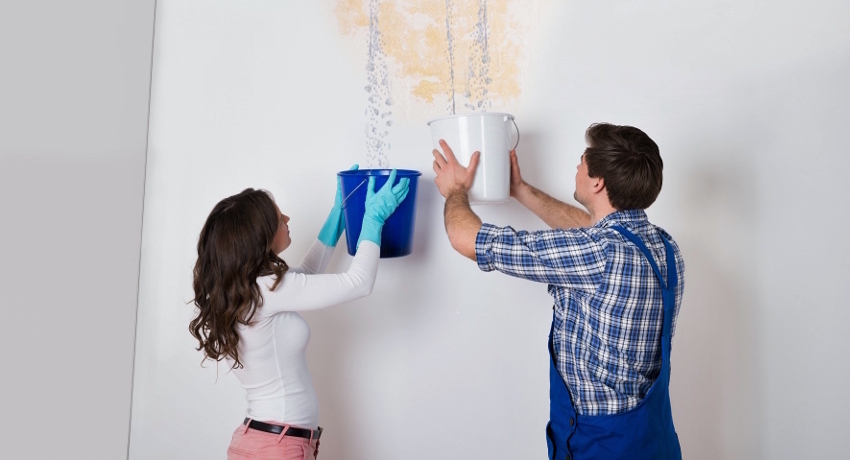
When pouring stretch ceilings, you can drain the water yourself and restore the canvas
Content
-
1 How to drain water from a stretch ceiling correctly and why you need it
- 1.1 How do different types of stretch ceilings behave in a flood?
- 1.2 Why do you need to drain water from stretch ceilings
-
2 Where can water come from in a stretch ceiling: what to do in case of a flood
- 2.1 What to do if the stretch ceiling in the apartment is flooded
-
3 Who to hire to drain water from a stretch ceiling: cost of services and compensation for damage
- 3.1 How much does it cost to drain water from a stretch ceiling: prices for professional services
-
4 How to drain water from a stretch ceiling yourself: ways to remove liquid and possible mistakes
- 4.1 Draining water from a stretch ceiling through a technical opening
- 4.2 How water is pumped from a stretch ceiling over the edge of the canvas
- 4.3 How to dry a stretch ceiling yourself after flooding and hide yellow spots
- 5 How water is drained from stretch ceilings: video
How to drain water from a stretch ceiling correctly and why you need it
Stretch structures are a common finish for a ceiling base. This type of coating has many advantages, including a huge selection of design solutions, colors and textures.

The canvas is able to retain moisture under the ceiling
Stretch ceilings have excellent technical and operational characteristics. The canvases of such structures are moisture resistant, they are capable of stretching while maintaining strength, as well as retaining large volumes of liquid. All these properties of the material will manifest themselves in the best way if the stretch ceilings are flooded. The owner of the apartment will only have to carefully get rid of the water and bring the coating into proper form.
An important advantage of tension structures is the fact that only the ceiling of the room suffers from leakage. The furnishings and interior decoration are completely intact. All moisture is reliably held inside the stretch ceiling, which acts as a kind of airtight bag.
How do different types of stretch ceilings behave in a flood?
When buying materials for arranging a stretch ceiling, be sure to pay attention to the markings. Conscientious manufacturers provide detailed information on the technical characteristics and performance of their products.
To understand how reliable the canvas is with respect to leaks, it is enough to look at indicators such as moisture resistance and the volume of liquid that 1 m² of the ceiling can withstand. Film coatings are designed for a pressure of 100 l / m². For ceilings with fabric canvases, this indicator varies depending on the quality of the material.

Cloths for ceilings have different technical characteristics and performance properties.
If the stretch ceiling sags in the room, it means that water has got into the room. Under its pressure, the elastic web is stretched and lowered. As a result, the coating becomes like a bubble or droplet hanging.
Note!If the liquid stops flowing and the canvas remains intact, this means that the ceiling can withstand water pressure for a long time. This period is relative and is about 2-3 days. But this does not mean that you have to wait until the last moment to drain the water from the false ceiling. As soon as a problem has arisen, it must be urgently eliminated.
The serious consequences of a flood can be easily avoided if you know how to remove water from the ceiling (from stretch canvases the liquid can be drained in different ways, and the approach depends on the design features and the premises). For finishing, fabrics and coverings in the form of PVC films are used. Sometimes there are combined options, consisting of a plasterboard suspended structure and a stretch ceiling.
To improve the strength characteristics and increase the elasticity of the material, fabric fabrics are treated with a special compound. An impregnation based on polyurethane imparts moisture-repellent properties to the coating. However, woven fabrics are not able to retain water for a long time. Liquid will still seep through the fibrous structure of the material. For this reason, it is not recommended to install fabric ceilings in rooms with a high risk of flooding (kitchen, bathroom).

PVC film is a durable coating for ceiling structures that is able to retain moisture under the ceiling
Ceiling structures made of PVC are considered a more reliable option. The film coating is completely sealed and completely impervious to water. If you properly drain the water from the stretch ceiling, you can count on the complete restoration of the canvas.
Why do you need to drain water from stretch ceilings
Draining water from the ceiling is a rather laborious procedure that requires preparation. If there is not enough time, it can be postponed for a while, but provided that the source of the leak is identified and the liquid no longer enters the apartment. Vinyl can hold water for a long time, but don't be too slow. Even if a small amount of liquid has accumulated under the ceiling space, you need to pump out water from the stretch ceiling in the next two days. Otherwise, the joint area between the two parts of the soldered coating will crack.
If the water remains under the ceiling for too long, it can cause unpleasant consequences. Humidity is an ideal environment for mold to grow. If it hits the ceiling plate, you will have to completely remove the tension coating, as well as do a disinfecting surface treatment with antiseptic agents.
Helpful advice!Even if there are no visible signs of mold damage, experts recommend, for prevention purposes, to treat with an antiseptic those sections of the ceiling and stretch fabric that have come into contact with water.

High-quality installation of the ceiling structure can protect furniture and appliances from the bay
Black mold not only spoils the appearance of the finish, but also worsens the indoor climate. Such conditions are unfavorable for humans. In summer, after flooding, tension canvases can dry out on their own. In the cold season, when there is high humidity and the air temperature drops, you will have to make an effort to eliminate the likelihood of mold. The owner of the apartment can independently drain the water from the stretch ceiling, but it is better to entrust its drying to professionals.
The presence of a leak in the house is associated with other unpleasant consequences. The canvas can accidentally break off (if the installation of the ceiling was of poor quality), and the presence of liquid in the ceiling space stretches the fabric. After that, it will be more difficult to restore the previous appearance of the canvas. Therefore, it is very important not to delay solving the problem if the neighbors from the upper floor flooded the stretch ceiling.
Where can water come from in a stretch ceiling: what to do in case of a flood
There may be water in the stretch ceiling for various reasons. The consequences of its impact, as well as the ways to eliminate them, depend on the finishing material, the volume of the liquid, the duration of its stay and many other factors. First of all, you need to establish the cause of the flood and determine what type of liquid enters the apartment.
As a result of a leak, the following liquid can enter the stretch ceiling:
- Cold water - in case of a rupture of the main pipeline.
- Hot water - if there is a breakdown of the centralized water supply or heating system.
- Drains - if there is a leak in the sewer.
- Rainwater - if storm drains are disturbed or the roof of the building is damaged (relevant for the upper floors).
- Soapy water - may come from neighbors whose washing machine or dishwasher is broken.
- Technical liquid, antifreeze - in case of a breakdown of the autonomous type heating system.

The type of liquid that can get under the ceiling depends on the location of the communications in the house
In rare cases, dry leaks occur. In hot weather, condensation forms under the coating, which can accumulate on the inner surface of the stretch fabric.
Note!The least harmful for stretch ceilings is water from the main pipeline. Cold liquid, like soapy liquid, is not as aggressive, so the damage from such a leak will be minimal. If hot water or sewage flows into the apartment, you need to act immediately, otherwise the canvas will be severely deformed and become unusable.
What to do if the stretch ceiling in the apartment is flooded
A well-installed coating will be able to retain liquid for some time, so do not panic if a leak occurs. In such a situation, you need to clearly follow certain rules.
What to do if neighbors from above are drowning? In this case, it is necessary:
- De-energize the apartment.
- Identify and eliminate the source of the leak.
- Take valuables out of the room or cover with foil.
- Call specialists.
- Contact the company that installed the structure, or, having carefully prepared, drain the water from the stretch ceiling yourself.

When pouring a stretch ceiling, it is necessary to de-energize the apartment in order to prevent a short circuit
Usually, communications (lighting devices, electrical wiring) are hidden between the ceiling plate and the stretched canvas. These components must never be flooded, otherwise a short circuit and fire may occur. To prevent this, at the first signs of a leak, you must immediately de-energize the apartment. Conventional switchboards have a switch that must be turned. More modern options are controlled by an automatic machine, it should be turned off.
Then you need to identify the source of the leak and block the access of liquid to the room. It is very important to stop the water as soon as possible to prevent the web from breaking. If the liquid comes from the upper apartment, you must immediately inform the neighbors. They will turn off the water. If there are no neighbors at home, the supply is shut off throughout the riser using a common valve. It is usually located in the basement of the house, so it is advisable to find out in advance who has the keys to this room. Most often it is the concierge, the head of the house or entrance.
The riser is also closed in cases where there has been a break in the pipes of the sewer or heating systems, and then the emergency service is called. If you need to urgently turn off the water, you can contact the police. It is forbidden to independently try to open the neighbors' apartment. This will be regarded as illegal entry into private territory.
Before removing water from the stretch ceiling, you need to remove electrical appliances from the room and, if possible, take out all valuable things. The rest can be covered with plastic wrap. This applies to upholstered furniture and expensive flooring.

It is necessary to drain the water accumulated under the ceiling after completing all the preparatory steps.
Helpful advice!It is advisable to find out in advance the phone number of a housing department or a service company, since when the riser is disconnected, you will have to remove the seal.
Who to hire to drain water from a stretch ceiling: cost of services and compensation for damage
When the leak is stopped, you need to fix all the defects in the photo before draining the water from the stretch ceiling. The cost of damages will be determined based on this evidence. If neighbors were to blame for the flood, they must compensate for the damage. In cases where a defective roof became the source of the problem, representatives of the housing department are engaged in compensation for losses.
If the tension web was installed in violation of the technology or it turned out to be of poor quality, i.e. not corresponds to the declared characteristics, compensation must also be paid by the company that performed the installation ceilings.
How much does it cost to drain water from a stretch ceiling: prices for professional services
It is not difficult for a qualified specialist to drain the water from the stretch ceiling. The prices for the services of such a master depend on many nuances.
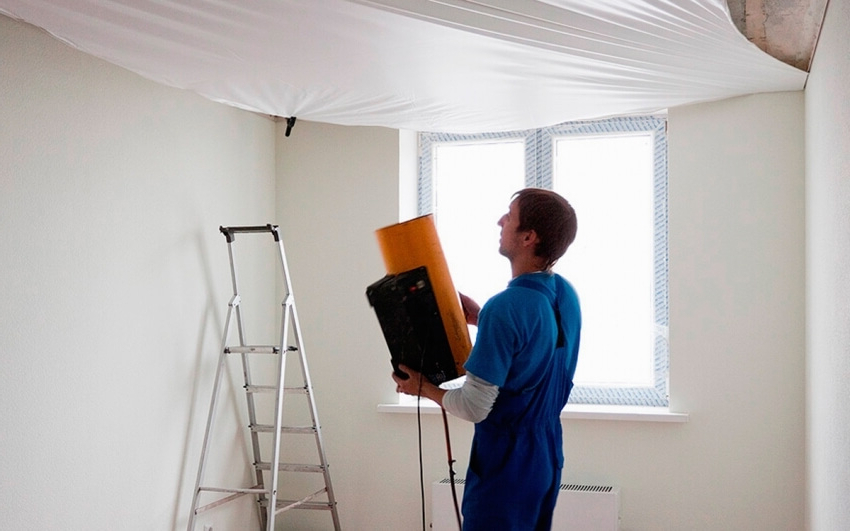
Companies that install ceiling structures can offer services for draining water from under the ceilings.
The cost of draining water and the subsequent restoration of ceilings is influenced by the following factors:
- the type of liquid with which the stretch web was in contact;
- fluid temperature;
- coating drying method;
- the degree of damage to the ceilings.
On average, it takes about 30 minutes to drain water from the ceiling space. So much time is required to complete the work, provided that the base base remains intact, the layer of plaster is intact and there is no debris. The average cost of the service is 3000 rubles.
If the homeowner decides to drain the water from the stretch ceiling on his own, he can hire specialists to restore the previous type of canvas and repair it. It is advisable to contact the company that installed the coating. Many companies provide a warranty for the installation. Therefore, in the event of a flood, they will easily eliminate all the consequences of the leak and provide a discount on repairs.
If the plaster has fallen from the ceiling, you should not refuse services to restore the coating. Pieces of trim can leave streaks behind. This applies to both film and fabric coverings. In such cases, it is recommended to completely remove the blade, clean it and reinstall it.
Restoration of the coating after draining water from a stretch ceiling: prices for professional services:
| Name of service | price, rub. |
| Cleaning | from 300 |
| Repairing a cut with a PVC patch | from 400 |
| Drying the canvas | from 1000 |
| Elimination of the "walking" effect of the canvas | from 1000 |
| Elimination of the "suction" effect | from 1000 |
| Elimination of the "sagging" effect | from 2500 |
Important!If the warranty has not expired, it is better to hire specialists to drain the liquid. They will also help in cases where the room has high ceilings or a multi-level structure is installed.
How to drain water from a stretch ceiling yourself: ways to remove liquid and possible mistakes
Some apartment owners are trying to solve the problem on their own, while making a lot of mistakes. Before you independently drain the water from the stretch ceiling, you need to soberly assess your capabilities and carefully prepare for this procedure.
The first step is to find a sufficient number of empty containers. When looking at a hanging canvas, it is very difficult to accurately determine the volume of liquid that is there. As a rule, there is three times more water than it seems. Do not smooth the canvas by spreading liquid with your hands, or prop up the bubble to relieve pressure. This can rupture the coating or aggravate the condition of the rough substrate and the film itself, which will be further saturated with moisture.
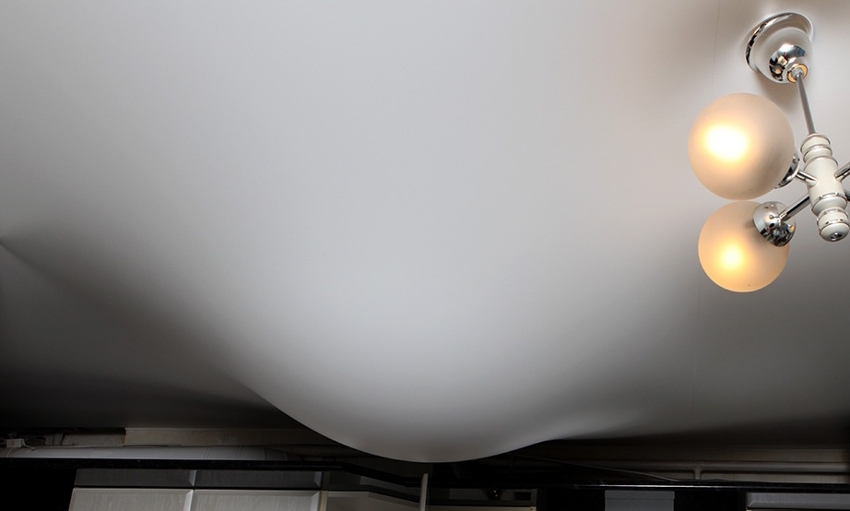
Cloths treated with a special compound are more moisture resistant
At least two people should be involved in emptying the stretch ceiling with water. It is impossible to cope with this task alone. We need an assistant who will hold the containers and change them as they fill. It is strictly forbidden to pierce the water bubble or make cuts in it. Even the smallest hole will very quickly become a huge hole under the weight of the liquid. In most cases, a bladder puncture leads to an instant rupture of the coating, as a result of which the entire volume of water is on the floor.
Related article:
Stretch ceilings for the bedroom. Photo options. Lighting selection
Photo of stretch ceilings. Choosing the right option for the bedroom. The nuances of choosing a color scheme. Lighting: types of lamps, location.
Draining water from a stretch ceiling through a technical opening
The technical openings include the places where the lighting fixtures are installed in the ceiling. For work you will need ladder or other stable support, a sufficient number of empty containers, a small diameter hose and tools to remove the luminaire.
How to remove water from stretch ceilings yourself? This will require:
- Dismantle the lighting device, which is located in the immediate vicinity of the accumulation of liquid inside the canvas. The apartment must be de-energized.
- Put a hose through the hole from the lamp, the other end of which must be lowered into a container to collect water. If you don't have a hose at hand, you can gently pull the cover down until the liquid starts to drain directly into the bucket. To do this, you need to put your fingers into a reinforcing ring designed to fix the canvas around the lamp, and grab it in several places so that the pressure is evenly distributed.
- The canvas should be stretched until there is no water inside. If there is too much fluid, a second person can gently lift the middle of the bladder to allow drainage.

Modern materials for ceiling structures have a variety of colors.
If the liquid stops flowing into the bucket, then the work on draining the water is finished. Before proceeding with the installation of the lighting device and turning on the electricity, the canvas must be dried. Depending on the material and the degree of soaking, this takes 2 to 14 days (when dried naturally).
Helpful advice!A hose in combination with a low-power pump will greatly simplify and speed up the process.
How water is pumped from a stretch ceiling over the edge of the canvas
In some cases, water can accumulate too far from the lighting fixtures, then the liquid is drained over the edge of the canvas.
Preparing the ceiling for draining water:
- First, you need to find the section of the tension structure, which is closest to the place of the greatest accumulation of water.
- In this area, a partial dismantling of the ceiling plinth is carried out.
- The film is detached from the wall so that a small gap is formed. In this case, the canvas must be held very tightly.

Using a screwdriver, you can independently remove the fabric from the ceiling plinth
You will need a screwdriver to remove the skirting board. Be sure to wrap the tool with a soft cloth, otherwise sharp edges will damage the film. The screwdriver is inserted into the profile groove, after which you should bend the bar until the hidden mount is exposed. Using pliers, you need to pick up the harpoon and carefully remove it from the profile. To perform this operation, you will need to disconnect 20 cm of the canvas. After that, you can start pumping out the water.
If a small amount of liquid has accumulated inside the ceiling, it is recommended to drain it by substituting a bucket and slightly lowering the edge of the canvas. If there is too much water, a hose will be needed.
The room can be flooded not only cold, but also hot water. In such cases, you need to act very carefully. Using thermal gloves will help protect your hands from burns. In order not to take risks, it is better to entrust such work to professionals. The likelihood of accidental rupture of the canvas increases significantly if a bubble of water hangs over the sharp edge of the furniture.
How to dry a stretch ceiling yourself after flooding and hide yellow spots
A construction hairdryer is used to dry the damp cloth. The use of a heat gun is also allowed, but it must be handled very carefully. This tool can dry out the film and ruin it. It takes about 3-5 hours on average to remove moisture. If the ceilings of the room are covered with a thick layer of plaster and at the same time they are heavily saturated with water, drying can take from 2 to 4 days.
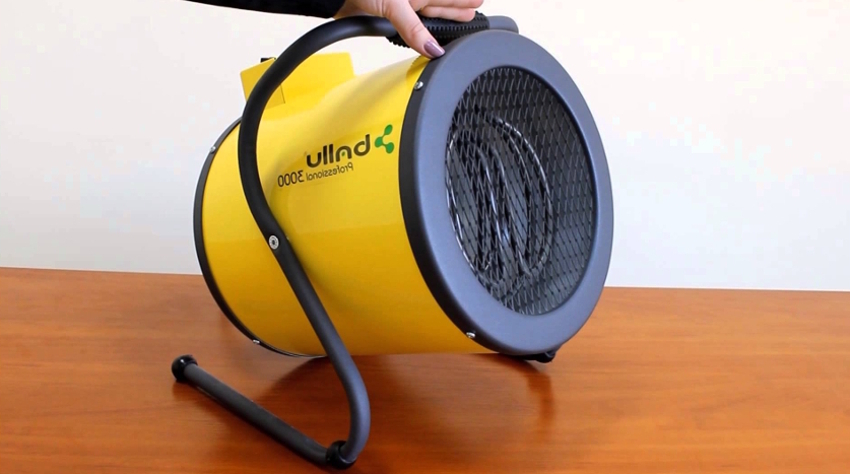
When drying the canvas with a heat gun, you must observe safety measures
First, the stretch ceiling covering is warmed up. As it cools, it will gradually level out. Do not use a hair dryer for these purposes. The power of this device is not enough to perform such an operation. In order not to melt the film when heated, the construction hair dryer should be kept at a distance of at least 20-30 cm from the surface of the stretched ceiling. It is not necessary to direct the air flow to one point, the heating should be uniform.
Sometimes yellowness appears on the surface of the canvas. This can happen even if the water has been drained off promptly. In such cases, it is best to contact the installer and inquire about how to remove the yellow stain on the ceiling after flooding. Often, stretch canvases are painted over. A specialist will advise which type of paint is preferable. Fabric constructions can be dyed up to 5-10 times. A soap solution is used to clean the film coating.

Stretch ceiling canvases can be washed periodically to maintain cleanliness
If there is too much yellowness and it shows through even through the paint, soda ash will help eliminate the problem. For cleaning, you need to prepare a solution (5%), which is used to treat the stain on the surface of the coating. After the baking soda dries, rinse it off with warm water. The procedure should be carried out until the macula is completely gone.
Knowing how to properly drain water from a stretch ceiling, you can independently eliminate the consequences of a flood. In case of any difficulties, it is still recommended to use the help of professionals.


